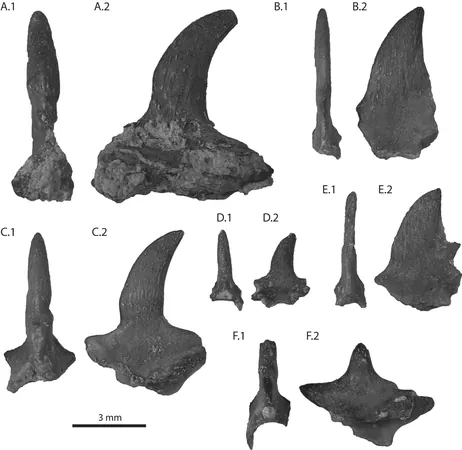
Newly Discovered Tanystropheid Unlocks Secrets of Triassic Ecosystems
2025-08-17
Author: Daniel
Groundbreaking Discovery at Petrified Forest National Park
A team of researchers has unveiled an exciting find in Arizona's Petrified Forest National Park: three unique tanystropheid taxa, including a newly identified genus and species named Akidostropheus oligos. This remarkable creature is characterized by a striking spike that protrudes from its spine, hinting at intriguing evolutionary adaptations.
An Ancient Era of Diversity and Evolution
The Tanystropheid family, part of the archosauromorph reptiles, thrived in the Triassic Period following the Permian extinction. These reptiles, some of which led to modern-day crocodilians, birds, and perhaps even turtles, showcased a rich diversity in body shapes and ecological roles, adapting to both marine and freshwater environments.
Revealing the Complexity of Triassic Life
The recent study, titled "A Diverse Assemblage of Tanystropheid Archosauromorphs from the Continental Interior of Late Triassic Pangea Includes a New Taxon (Akidostropheus oligos gen. et sp. nov.)," published in *Palaeodiversity*, classifies the previously unrecognized A. oligos alongside other distinct taxa, including an affiliated Tanystropheus, based on unique cervical vertebrae shapes.
Paleontological Exploration and Challenges
At a specific site known as Thunderstorm Ridge, researchers retrieved hundreds of tanystropheid bones. These fossils were painstakingly collected through meticulous techniques, such as hand quarrying and fine screening. However, due to their disarticulated state, identifying exact associations proved challenging.
Key Features of the New Species
The newly identified Akidostropheus oligos features diminutive vertebrae coupled with its signature dorsal spike, which is believed to have served as a defensive mechanism against predators. The spine's striated appearance suggests the possibility of a keratinous covering, hinting at complex evolutionary traits.
Implications for Understanding Ecosystem Dynamics
The unexpected variety among these tanystropheid species points to a thriving semi-tropical ecosystem, where diverse nonmarine environments may have fostered significant speciation and ecological diversification during the Triassic. This discovery not only enhances our understanding of prehistoric life but also enriches our grasp of evolutionary biology, providing vital three-dimensional anatomical insights into a group often limited to two-dimensional fossils.
A Window into the Past
The findings underscore the evolutionary significance of the tanystropheids and their adaptive strategies in the face of environmental changes millions of years ago. As scientists continue to dig deeper, each new discovery helps piece together the vast puzzle of life during the age of dinosaurs.



 Brasil (PT)
Brasil (PT)
 Canada (EN)
Canada (EN)
 Chile (ES)
Chile (ES)
 Česko (CS)
Česko (CS)
 대한민국 (KO)
대한민국 (KO)
 España (ES)
España (ES)
 France (FR)
France (FR)
 Hong Kong (EN)
Hong Kong (EN)
 Italia (IT)
Italia (IT)
 日本 (JA)
日本 (JA)
 Magyarország (HU)
Magyarország (HU)
 Norge (NO)
Norge (NO)
 Polska (PL)
Polska (PL)
 Schweiz (DE)
Schweiz (DE)
 Singapore (EN)
Singapore (EN)
 Sverige (SV)
Sverige (SV)
 Suomi (FI)
Suomi (FI)
 Türkiye (TR)
Türkiye (TR)
 الإمارات العربية المتحدة (AR)
الإمارات العربية المتحدة (AR)